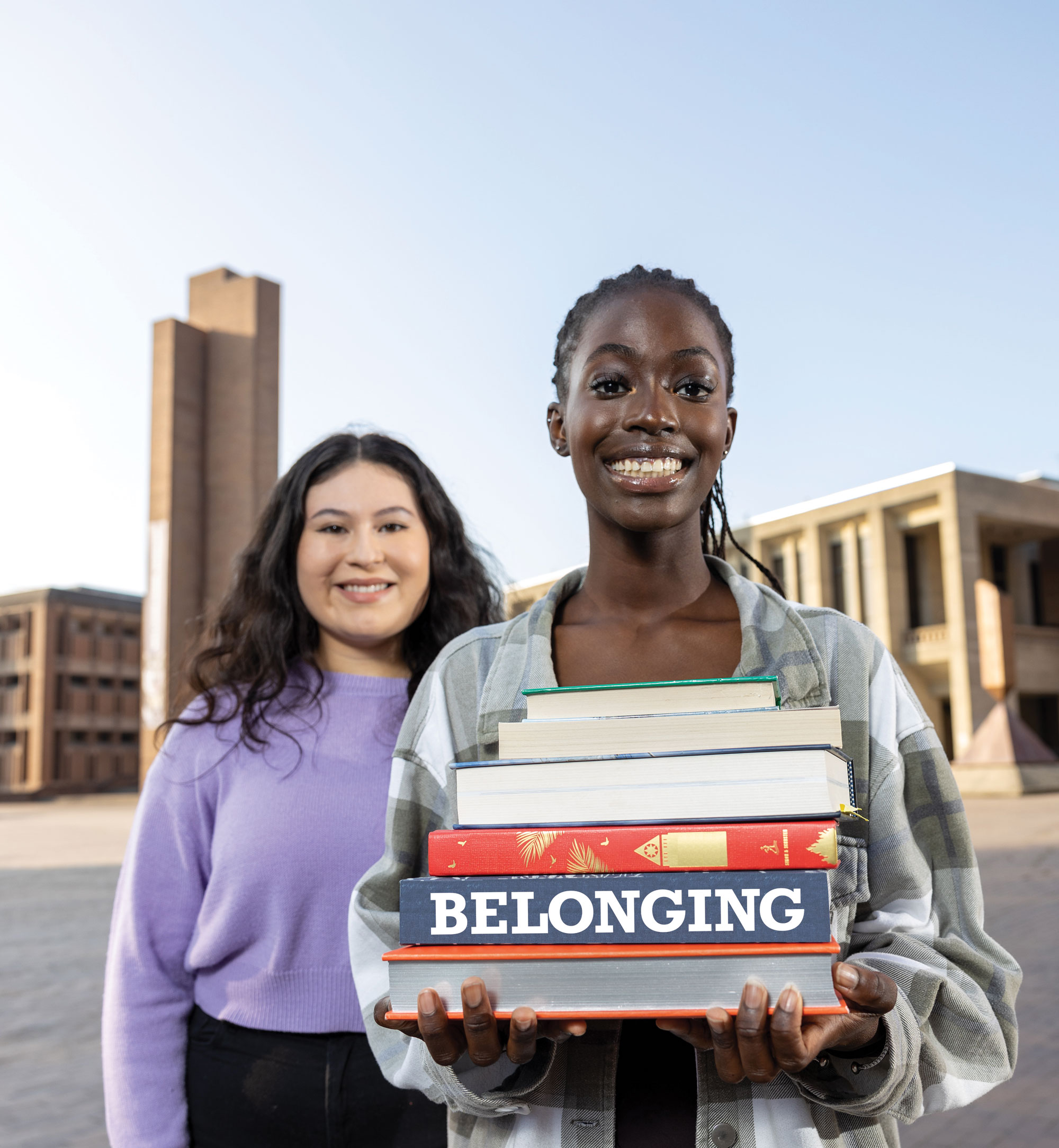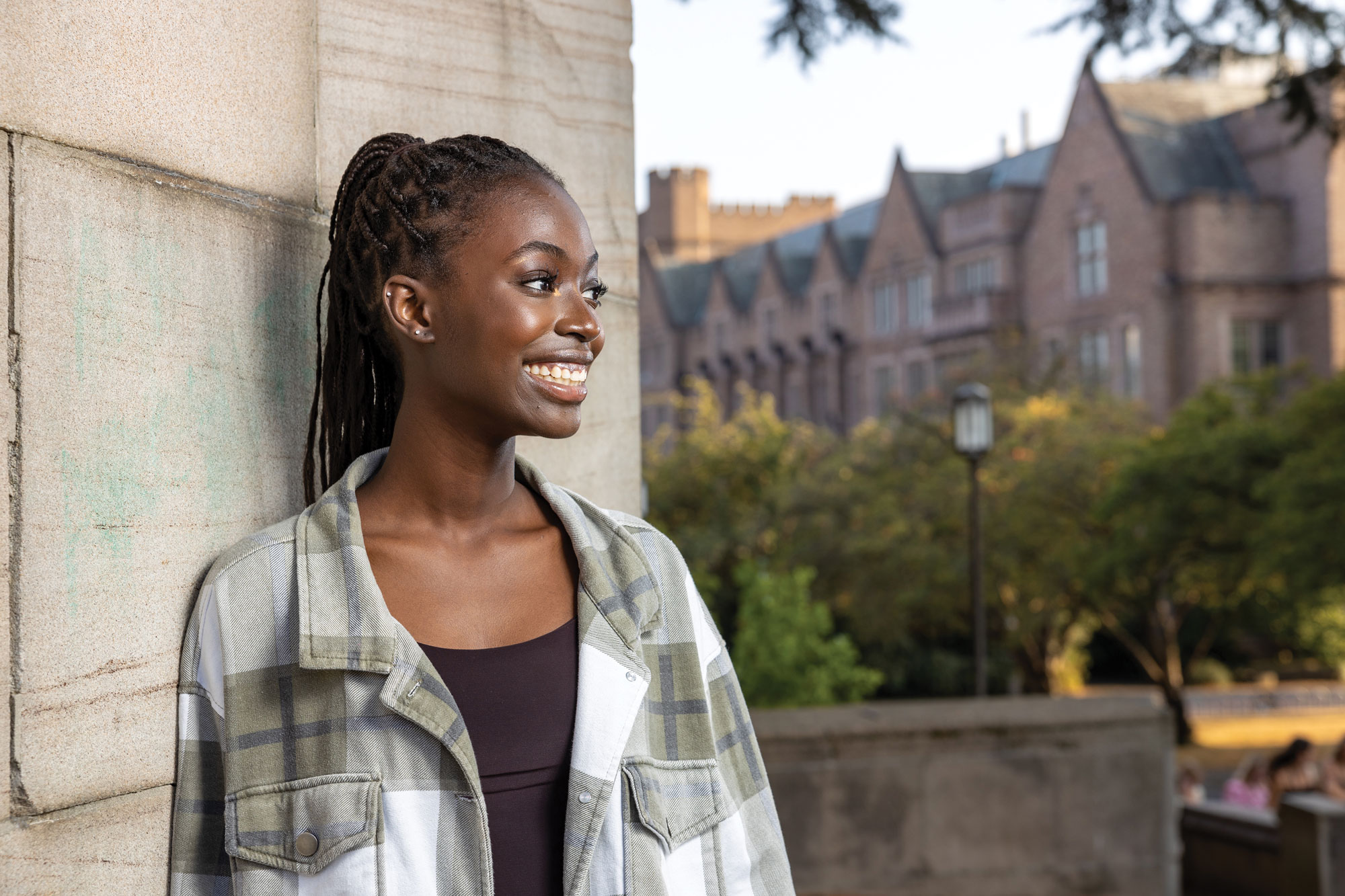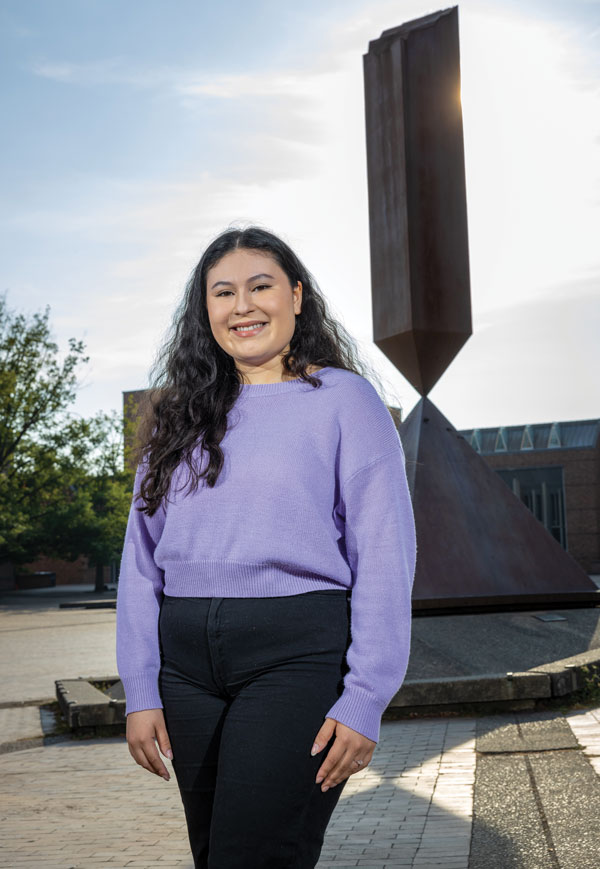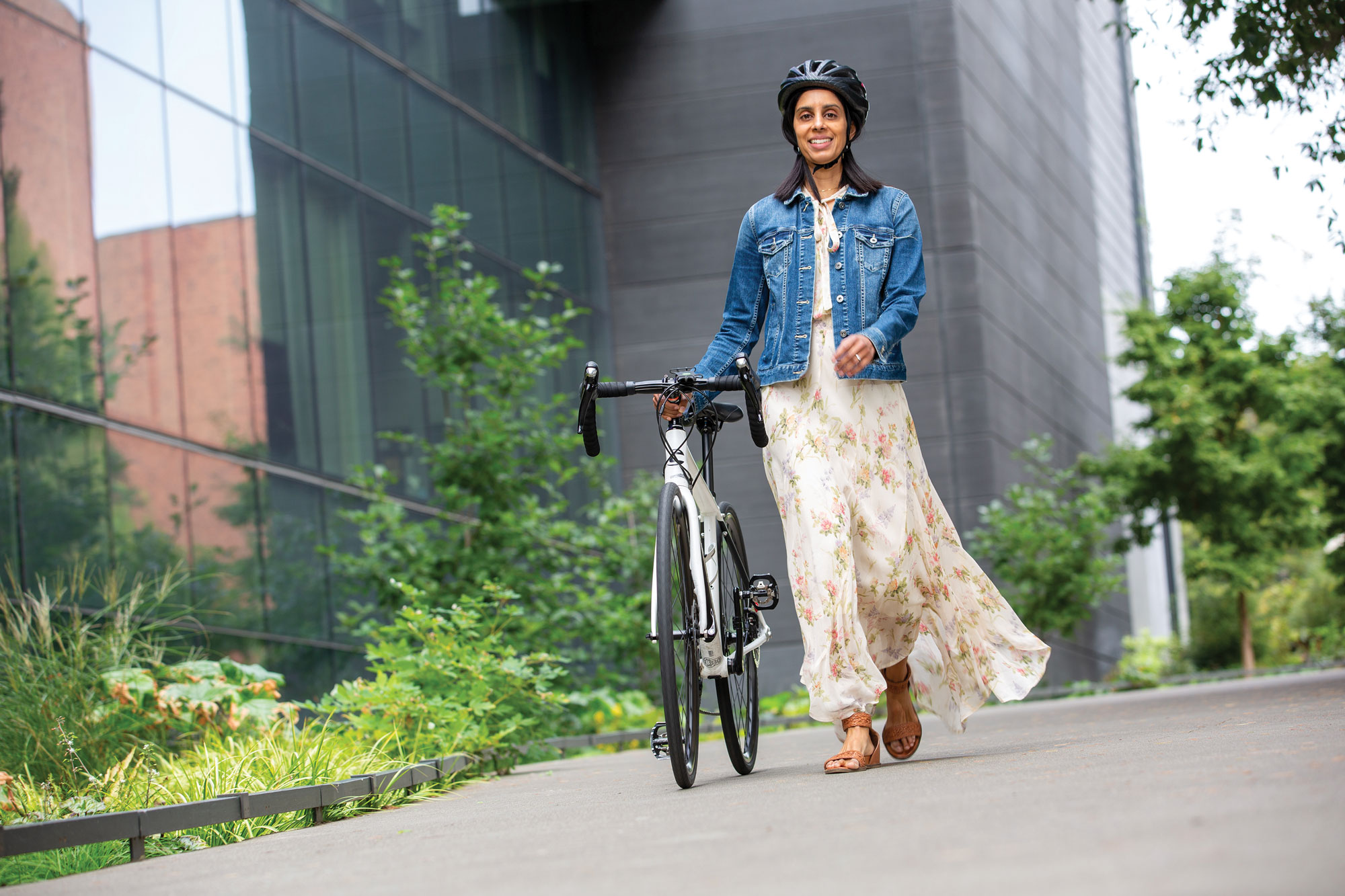At home on campus At home on campus At home on campus
Studies show that students who feel a sense of belonging—of being connected to community, place and purpose—are more likely to thrive in college and experience better personal wellbeing.

Studies show that students who feel a sense of belonging—of being connected to community, place and purpose—are more likely to thrive in college and experience better personal wellbeing.
Fall quarter started out strong for Fatima Gbla, a junior pursuing a degree in molecular, cell and developmental biology. With classes, good friends, several student clubs and an advisory role in the Office of Minority Affairs & Diversity, she was on the go. She even attended the groundbreaking for a new campus building.
But in her first year, Gbla struggled to feel at home at the UW. Her challenge was rooted, in part, in not immediately finding other Black and African students. And she still deals with the sense of being an outsider.
“I often feel out of place in terms of how I am perceived and understood by my classmates,” says Gbla, whose family immigrated from West Africa. “Even if I might be included in things like group discussions and clubs, I often lack the feeling that I actually belong in that space.”
That feeling of not belonging—not being at home in the university—is one that “has been most frequent among minority students that I have encountered,” Gbla says, “especially within STEM classes, where your intelligence and effort is tested the most as you are pitted against students who have had more access to quality education and resources.”
Few people walk into a university for the first time and feel like they belong. And for some, particularly underrepresented and non-traditional students, the feeling can worsen during their first weeks or months on campus. Since the late 1960s, universities across the country have worked to increase access and diversity for underrepresented students and faculty. The concept of DE&I (diversity, equity and inclusion) became a core focus in academia. But now the UW and other schools have expanded DE&I work to prioritize belonging—to make campus a place where individuals feel invited to be themselves. Where they are accepted, included and—like Gbla in her advisory role—engaged.
For her part, Gbla worked to root herself in a community of peers, which she discovered in the Black Student Union and the African Student Association. “Initially, I was a bit fearful opening up to members of these clubs, since I was so used to feeling like an outcast,” she says.
“However, once I was able to understand that these students had similar experiences and could relate to me in a way that no other student could, I finally began to feel as if I found my own community, which led me to finding my own identity beyond what I felt I was labeled as.”

Fatima Gbla, a junior, didn’t feel like she belonged when she started at the UW, particularly in her science major. She found a community of peers, though, through the Black Student Union and the African Student Association. Now she’s a member of the First Year Experience Advisory Council.
Belonging is a concept that psychologists started exploring in earnest in the 1990s. The idea is that belonging is a human need, like food and shelter, says Professor Sapna Cheryan, a social psychologist and director of the UW Stereotypes, Identity & Belonging Lab. People need to belong to thrive. That sense of belonging may be affected by the way the university interacts with facets of their identity, Cheryan says. It could be in the way classes are designed, or even in the spaces where they’re taught.
In the late 1980s and early ’90s, academia started to see the relationship between belonging and student well-being and engagement. In 1987, the UW started a First-year Interest Group program that created small communities of students who shared academic interests and took classes together, with the idea that they would provide community for one another.
“We know that being at an institution where you feel safe and embraced is critical to student success,” says Denzil Suite, vice president for Student Life. “There is ample research that shows that students who feel connected to campus, who feel a sense of community and who participate in organized activities fare much better academically than those who feel isolated.”
Today, efforts to build student belonging at the UW start before admission. Shades of Purple, a summer workshop, brings hundreds of high school seniors from underrepresented communities in Washington to explore campus together and learn about the admissions process.
Another key moment comes at the beginning of the school year. A week after classes start, students are invited to community welcome celebrations at the Kelly Ethnic Cultural Center (ECC). Some events are centered on students from specific cultures and ethnicities including Alaskan Native/American Indian, Asian/Asian American, Black, Latine, Pacific Islander and undocumented.
But there’s a difference between talking about belonging and changing a place like a university where the buildings and classes had been designed with one particular type of student in mind. Schools try to counter this by reaching out to the students with messaging that they all belong. The problem, says Cheryan, is that institutions that spend too much time reiterating that “you belong” can cause students to wonder whether they actually do. Instead, schools need to look at all their structures and systems—even how they build classrooms and residence halls and how they approach their subjects—and adapt them to serve the students of today.
“The sheer amount of white people in my classes was enough to deter me and [left me] just feeling scared to even ask questions,” says senior Isabel Corona-Campiz, a first-generation student from Royal City. In her science classes, it seemed like the other students had already learned the content in high school, “and it was my first time hearing about it.”

Isabel Corona-Campiz didn’t feel fully at home as an environmental studies major. She added a second major in ethnic studies where she found classmates and teachers with whom she could more easily relate. Now a senior, she has a job at the Kelly Ethnic Cultural Center that allows her to support other students as they create clubs and events that make the UW more inclusive.
In one of Corona-Campiz’s environmental studies classes, there was a focus on pesticides. The discussion centered on how the environment was affected, but Corona-Campiz thought the conversation should include people. She knew that agricultural workers, like those from her hometown, would also be affected.
Corona-Campiz decided to seek classes outside her major that offered content, students and faculty she related to. She ended up with an additional major in ethnic studies. It deepened her connection to the pockets of home she found on campus, she says. “I feel like I belong there because I feel like that group of people is generally involved in other things. They’re also at the ECC or also use different resources under the OMA&D umbrella,” she says. “Ethnic studies is more of a community-based major. For the past three years I’ve been seeing the same people over and over again, which is pretty comforting, especially at the UW, which is huge.”
It can go beyond just feeling comfortable in a space. Deep belonging includes a point of contribution, of being known, needed and loved. In her junior year, Corona-Campiz found a job at the Kelly ECC, where she is the student leadership programs assistant. She supports other students as they seek to develop programs and spaces that are inclusive to them.
Campus is one thing. Feeling like you belong in your field of study is another. STEM (science, technology, engineering and math) fields, for example, struggle to attract and retain Black, Hispanic and women students.
Cheryan’s lab studies belonging in fields including engineering and computer science. Stereotypes, she says, can dissuade girls as early as elementary school from even pursuing STEM careers.
What do students imagine when they think about what a computer scientist or physicist looks like? The iconic leaders represent a narrow group of people, she says. They’re usually white men, people who grew up with a lot of privilege. They drink energy drinks, are obsessed with computers and like science fiction. That’s problematic, because the stereotypes shape who aspires to be in these fields, Cheryan says. A lot of people don’t fit that image.

Professor Sapna Cheryan, an expert in social psychology, explores stereotypes, identity and belonging. Among the questions under investigation in her lab are why women are underrepresented in STEM, how identities interact and how to address institutional racism.
There is also the issue of “ambient belonging,” a term her lab came up with to capture the idea that a person can feel out of place based on what a classroom or laboratory looks like. In a more inclusive, gender-neutral space, it may be that a computer lab is decorated with plants instead of “Star Trek” posters.
Cheryan has seen where changes in cultural practices, expanding the way people interact and showcasing new role models can go far in making a class or program feel more inclusive.
While masculine stereotypes for fields like computer science start early and are pervasive, it’s not too late when you get to college, Cheryan says. As computer science departments around the country are changing their cultures to be more welcoming and inclusive, they are building a more diverse faculty. As a result, more women will graduate in that field, she says.
The UW’s ADVANCE Center for Institutional Change is at the heart of some of those improvements. The center was started in 2001 with a $3.75 million grant from the National Science Foundation and focuses on addressing the underrepresentation of women faculty in science and engineering. If the adage “You can’t be what you can’t see” has any truth to it, Joyce Yen, the program director, and her team are working to make sure women students and faculty can see women thriving in powerful places in STEM fields. “There is power in community, even a community of just two,” Yen says. “It’s not solely up to individual students to solve these issues for themselves. But if the structures and systems are not yet meeting these needs, then we can still create community for ourselves.”
Professor Cheryan is part of that community of UW women faculty. “We have been meeting every other week, sometimes more, since 2008 as a peer mentorship group,” she says. The group helps the professors navigate their departments, the university and the tenure process.
Cheryan’s insights on stereotypes, identity and belonging can also be seen at work in her own lab. Her students help define the ways they want to be together. They organize meetings outside of the lab and interact at cafes, happy hours, dinners and boba outings. “We share a desire to do research that helps the world, and the people in the lab are not only great researchers but also great people,” Cheryan says.
While the University’s focus on belonging includes undergraduates, staff and faculty, one group that often gets overlooked is older students. Margaret Lundberg, for example, had not taken a college class since 1975. When she returned to finish her undergraduate degree at UW Tacoma in 2009, she felt out of place. She describes being in the Dawghouse Student Lounge, with its video games, pool tables and loud music. “You know every moment that this place just wasn’t built for you,” she says.
Lundberg coped by swapping stories with other returning students. One of her challenges was figuring out how to write for school again. She would get writing assignments and ask, “What is APA style? Do we still do footnotes?” Once she figured it out for herself, she took a job at the UW Tacoma Writing Center, where she could help others facing the same challenges. There she met a student who had to bring along her 7- and 9-year-old children to tutoring sessions. She couldn’t afford child care and told Lundberg that she was about to become homeless.
This was hardly the first time Lundberg had heard of a returning student dealing with crisis-level hardship. “I’m hearing them,” she says. “Is anyone else hearing them?”
She decided to investigate and enshrine the rarely studied topic into academic literature. She focused her 2022 doctoral dissertation on women who return to complete their degree after the age of 35. Her research included interviewing eight older women returning as students. Lundberg found that once a student finds her community within the university, she develops a renewed energy to finish her degree and encourages others to do so too.
Of the eight students Lundberg interviewed in depth and identified by pseudonym for her dissertation, five were not white. One was a Native American woman [Omaha, Nez Perce and Winnebago] in her 50s who returned to the UW for her master’s in social work. She and her husband were also raising two grandchildren after their daughter died of COVID-19.
Being Indigenous, the woman knew she was out of place in academia and how few—historically less than 1 percent—Native Americans complete graduate degrees. She felt she always had to prove she deserved to be on campus. But she found belonging in the UW Tacoma library. There the staff treated her like a researcher and she began to see herself as part of a community of scholars. “It was a place that made me feel like I belonged and felt worthy of being at a university,” she told Lundberg.
She might not have finished her degree after her daughter died, but one of her professors showed insight and compassion, giving her extra time to complete her work and the feeling that she was cared for. He told her: “Don’t worry, I will get you through this.”
Now the woman has advice for anyone struggling with belonging. “First thing, you’ve got to believe what people say to you, especially when they’re good things,” she told Lundberg for her research. “And you hold on to it, and you take it in like a sponge and don’t wring it out. You hold on to it until it becomes part of you and then you can release it to let others know. To tell them about the thing that’s positive about them.”
Lundberg concluded her dissertation with these parting words: “Universities are coming to understand that they can—and indeed, must—revise themselves to be more inclusive of a wider range of student identities. This is the purpose of campus diversity programs like the Center for Equity and Inclusion, like first-generation support groups and veterans’ services; and I would suggest that this attention be extended to include mature returners as well.”